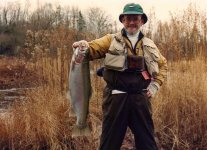FarmerDave wrote:
The odds of catching a trout in a remote stream with another fly in it's mouth are low. However, if one happens to catch a trout in a freestone stream with another fly in it's mouth, the odds of it being a size 14 Adams are not all that low. It is probably the most common dry fly used for freestone trout in the most common size.
Why? Hatches are not as predictable on freestone streams, and the Adams looks a little like everything and a lot like nothing.
All of you freestone trout anglers out there... raise your hand if you do not have any Adams in size 14 in your arsenal.
I'm not seeing any hands.
I'm also not the greatest knot tier, either.
My hand is raised high.
I don't tie or fish Adams - period.
Not because I don't think it's effective.
I just think that there a lot of easier to tie flies that work just as well.
IMO, a slate drake/ Iso pattern - simply tied with all gray materials - works fine
And I don't have to tie in a brown hackle with it.
Although I did have a rather odd experience with an Adams just last week.
I was fishing a large central PA stream, in which the fish were midging quite well.
As I was landing one of them - on a #26 midge - I noticed a large grayish fly hooked firmly hooked to its side. It was a #14 parachute Adams.
And even though I carefully handled the fish to avoid getting stuck by it, I still ended up getting jabbed pretty good.
Found out that the Adams had what looked like a sulphur nymph dropper dangling off the bend of the hook.
And it got me pretty good.
But I ended up getting 2 bonus flies back after the release.





